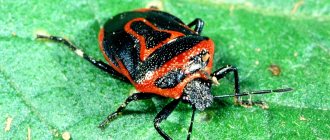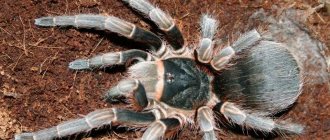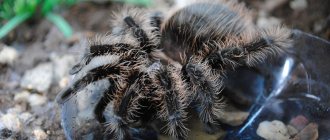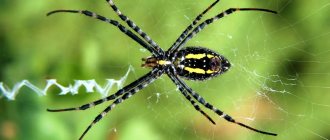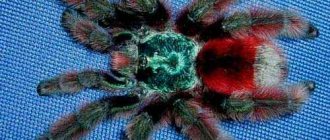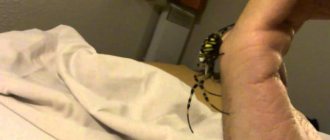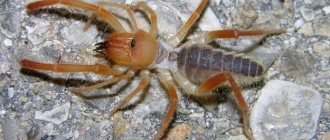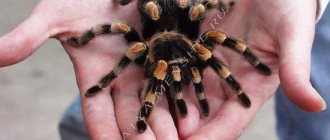Spreading
The metallic tree tarantula is found only in the state of Andhra Pradesh in India in the vicinity of the cities of Nandyal and Giddaluru.
The total area of its habitat does not exceed 100 square kilometers. The animal was first discovered in the bungalow of a railway engineer on the northwestern line of the Madras Railway in the town of Gooty, located a hundred miles from its habitat. Presumably it got there after traveling on a train. Subsequently, he was never found in this area again.
The caught specimen was described in 1899 by British arachnologist Reginald Pocock. For a long time, the species was considered extinct, until 102 years later it was found again in the jungle by Canadian zoologist Rick West and British naturalist Andrew Smith. The local population calls it a blue or blue spider.
Pecilotheria metallica is included in the list of the 100 most endangered species of the world's flora and fauna.
Interesting facts about spiders
- There are more than forty thousand species of spiders in the world.
- Small, poisonous spiders live in Chile. They usually live in dark and dusty corners, so Chileans always keep their houses clean. Sometimes they also introduce other spiders into their home, larger ones that are harmless to humans and feed on their small, poisonous relatives.
- The spider brain occupies on average a quarter of the body volume.
- Since spiders do not have ears, they hear sounds using hairs growing on their legs. They sense odors in the same way - with sensitive hairs.
- While some species of spiders are almost blind, others have very sharp vision.
- Spider web can withstand stretching up to four hundred percent of its original length.
- Spiders molt periodically, shedding their old chitinous shell and growing a new one.
- Cannibalism is common among some species of spiders.
- In almost all species, male spiders are smaller than females and are usually more variegated and brightly colored.
- The body length of the smallest spiders does not reach half a millimeter, and the largest ones reach nine centimeters (up to 25 taking into account the leg span).
- Spiders live all over the planet, in all countries.
- Some spiders can move quickly on the surface of the water.
- Only a small part of all types of poisonous spiders are dangerous to humans. These include, for example, karakurt, common in the south of Russia.
- In some countries, locals enjoy eating spiders.
- Arachnophobia is one of the most common phobias in people.
- Tarantulas got their name in honor of the Italian city of Taranto, in the vicinity of which they are common.
- Anteater spiders are very similar to the ants they hunt, and differ in appearance only by having eight legs instead of six. They penetrate anthills for prey, lifting up their front pair of legs and using them to imitate ant antennae, and then hunt.
- The overwhelming majority of spider species lead a solitary lifestyle.
- Not all spiders hunt using webs; some prefer to pounce on prey, like real predators.
- Singapore spiders are able to make a copy of themselves from various small debris caught in their web. This is a defense mechanism, as some wasps prey on spiders. While they are attacking the dummy, the spider may have time to escape.
- Spiders do not stick to their own webs thanks to the hairs on their legs.
- One of the species of spiders found in Hawaii has a smiley-face color on its back.
- Australian gladiator spiders spin square sacs of web, sneak up on their prey, and then cast their web over them.
- Most spiders are very useful creatures, as they destroy harmful insects.
- The strongest web in the world is produced by the Darwin spider. The threads of this web are about ten times stronger than Kevlar.
- The most aggressive type of arachnid is the banana spider. It often attacks everyone it sees, including people, and its poison is deadly.
- At one time, a spider can lay several thousand eggs.
- Water spiders can live underwater, creating air bubbles for themselves to breathe.
- Instead of blood, spiders have hemolymph. It is transparent, but turns light blue in air.
- Each spider has eight legs, and each leg has six knees.
- If the web catches prey that is too dangerous, such as a hornet, the small spider will likely break the web enough to allow the prey to fly away. This is safer for him than trying to wrap his prey in a cocoon - it can fight back.
- According to French scientists, in a moderately warm climate, spiders destroy about 400 million insects per hectare of land per year.
- The Arctic climate, which is harsh and cold, is home to about 1,000 species of spiders.
- Apparently, many of them are not afraid of the cold. Representatives of the species Euophrys omnisuperstes, related to jumping spiders, are found even high in the mountains, where most people simply cannot survive without an oxygen mask. Once a specimen of Euophrys omnisuperstes was even discovered on the summit of Everest.
- Jumping spiders got their name because many of them move by jumping. Moreover, in one jump they can cover a distance exceeding the length of their body by several tens of times.
stofaktov.rf/31-interesting-fact-about-spiders/
https://thefactum.com/10-interesnyh-faktov-kotorye-vy-ne-znali-o-paukah/
https://faktrus.ru/55-facts-about-spiders/
a brief description of
The tarantula is a spider, part of the group of arthropods, which has an exotic appearance. The main distinguishing feature of the arachnid representative is its large body size. Lives everywhere, found in countries with tropical climates.
The representative lives in burrows, on the ground, in bushes, and in trees. He prefers to be invisible, so he often hides, this allows him to easily catch prey. H
It often happens that nymphs initially live underground, and when they reach adulthood they move to the trees. Spiders are slow, making sudden movements when absolutely necessary. Well-fed females may not leave their homes for several months.
The characteristics of spiders include:
- The size of the spider's body ranges from 4 to 7 cm. During the span of the legs, it reaches 12-18 cm.
- the tarantula weighs from 60 to 100 grams;
- The body color of an arthropod can be varied; it fascinates with its iridescence, richness and brightness. There are representatives of this species with blue, green, monochrome black, rich yellow, emerald and other colors;
- the spider has a chitinous shell. After molting, it acquires the brightest color;
- On the surface of the insect's body there are hairs that perform a protective function. The insect can use them to weave nets. The hairs on the abdomen are poisonous;
- nature awarded the representative of this species with six pairs of legs. Four of them are the main limbs. The rest are chelicerae and pedipalps.
Despite the name, the arachnid is rarely satisfied with meat. He prefers lighter and more accessible food.
His diet consists:
- flies, crickets, locusts, cockroaches, grasshoppers and other insects;
- spiders;
- worms;
- frog;
- snake;
- fish fry;
- naked mice;
- chicks.
Males reach sexual maturity at 1-2 years, and females at 2-5 years. Before the mating season, males weave nets from cobwebs, onto which seminal fluid is applied.
During the mating season, the spider collects seminal fluid into a sac - the cymbium - and crawls towards the female. Using hooks, he holds her sexual organ and fills it with sperm, which is how fertilization occurs. After 1-8 months, the female forms a cocoon from the web, where she lays eggs.
It is worth considering that tarantulas are a group that unites various species of spiders. They have interesting features and distinctive qualities. Some of them are even used to maintain houses.
Lampropelma violaceopes
Special data of this type include the following facts:
- a large individual, at maturity reaching up to 9 cm in body length and up to 25 cm in paw span;
- can lead both burrowing and arboreal types of life;
- The color of the female is clearly expressed in blue-violet tones, which becomes more saturated with each molt;
- leads a nocturnal lifestyle;
- feeding mainly consists of hunting insects.
An extremely aggressive and fast spider, this pet is not suitable for novice keepers.
Cyriopagopus schioedtei
Cyriopagopus, a Malaysian species of tarantula, is quite rare in amateur collections due to its aggressiveness and difficulties in breeding. On sale it has a high price. The main features of this type include:
- the type of life is burrowing, and the individual can burrow to a depth of up to 7 cm;
- general body parameters can reach up to 8 cm with a paw span of up to 25 cm in males;
- The species grows quickly and sexual maturity occurs in males within a year, in females after 1.5 - 2 years.
The general temperature of such an individual should not drop below 24°C, with a total humidity of up to 85%. It is advisable to equip the terrarium with a sufficient amount of soil.
Poecilotheria metallica
Probably the most beautiful and rarest species of spider. The bright blue color with a beautiful ornament along the torso attracts the attention of many arachnid lovers.
But it is worth considering that the temper of this species is very aggressive, and if you add to it the high speed of reactions, then only professionals can have such a pet. General data of Poecilotheria metallica are as follows:
- body size can reach up to 8 cm with a limb span of up to 18 cm;
- the total lifespan of such a spider is about 15 years;
- leads an arboreal lifestyle, living on the treetops of the tropical forests of India;
- the temperature of keeping such a pet should not fall below 23°C, with humidity up to 80%.
Tarantula spider Petsiloteriya metallika
The species does not reproduce often in captivity; before mating, the male can stay with the female for some time without the danger of being eaten. If fertilization has occurred, then after a couple of months the female makes a cocoon, which can contain from 100 to 160 nymphs. The incubation period is about 2 months.
Unfortunately, almost all blue tarantula spiders have a strong toxic venom, and its bite can lead to allergic reactions, pain, nausea, dizziness and fever.
It is recommended to carry out any manipulations in the terrarium using long tweezers. Children and other pets should not be allowed near the blue tarantula.
But with a competent approach, proper maintenance and attentiveness of the owner, these species can add a great advantage to the entire collection.
Overall Difference
To date, more than 40 thousand species of arachnids have been officially registered. From the smallest common house spiders to large exotic tarantulas.
All of them differ not only in appearance, size, but also in the type of life activity. So tarantulas can be divided into the following types:
- ground. These species lead their lives on the surface of the earth. Often such specimens become prey to porcupines, possums and other predators;
- woody. Spiders of these orders also live on the ground in their youth, but after reaching puberty they move to trees. Even despite the presence of highly toxic poison, these representatives of the flora can be attacked by many animals;
- burrows. Probably the most adaptable species. The life activity of such spiders allows them to dig a hole sufficiently deep, which protects them from the outside world. But even when this species goes hunting, it faces great danger.
Where do they live?
Under natural conditions, these spiders are active at night, and during the day they hide in the crowns of trees. Also, young individuals often make homes for themselves at the base of a tree in earthen burrows, disguising them with cobwebs. Blue spiders live mainly in groups.
Help! The venom of these arthropods is potent. A human bite from an adult can lead to various allergic reactions, headaches, nausea, dizziness and fever.
Chromatopelma cyaneopubescens maintenance at home:
To keep the beautiful Chromatopelma cyaneopubescens you will need a cubic, or preferably vertical, terrarium. Since the spider is not large, the size of the terrarium may be slightly smaller than the standard 30x30x30 centimeters. If you don’t have a special terrarium, you can use various plastic containers; read for an example of creating an insectarium from a plastic container.
A moisture-absorbing substrate must be placed at the bottom of the terrarium with Chromatopelma cyaneopubescens. Coconut substrate works well, although others will work just as well. I recommend making a layer of substrate at least five centimeters due to the fact that Chromatopelma cyaneopubescens, according to some data, can dig holes (however, I note that I did not observe this with my lameness). A container of clean water must be placed in the terrarium for an adult tarantula spider. Also, the living space for Chromatopelma cyaneopubescens can be decorated with various decorations.
The temperature regime for Chromatopelma cyaneopubescens is 24-26 degrees Celsius. According to information from the Internet, this species can withstand short-term temperature drops of up to 15 degrees, but I, of course, do not recommend checking this information in practice. As mentioned above, Chromatopelma cyaneopubescens is demanding of slightly low humidity of 50-60%, i.e. There is practically no need to moisten the substrate, provided there is a drinking bowl with water.
Nutrition
Blue arthropods are predators. They do not feed on birds; the basis of their diet consists of grasshoppers, larvae of various insects, other smaller spiders and beetles, small frogs, locusts, etc. The spider's food does not exceed it in size; it does not dare to attack large prey. These predators do not use the web for hunting, but simply attack the prey. Having overtaken the prey, it injects poison into it, which paralyzes the victim’s body. Then it weaves a web around the insect and releases stomach acid into the immobilized body. After a short period of time, the insides of the prey soften and the predator begins to feed.
Description
In many countries, tarantula spiders are gaining popularity every day. There are a number of reasons for this.
- All spiders of this species have a beautiful color.
- Keeping a tarantula spider at home is not too expensive and quite simple.
- The tarantula spider looks very extravagant as a pet. And if traditional pets have become commonplace, then the spider will certainly arouse the interest of your guests.
The tarantula spider is a predator, but in nature these arthropods do not hunt large prey. Basically, these spiders feed on small insects, smaller spiders, as well as small rodents, small birds, fish, and maggots. The difference between this type of animal and others is that tarantula spiders do not use web traps for their prey; they wait and attack their prey from ambush and at a short distance.
Behavior in the wild
The body length of an adult arthropod can reach 50 mm. At the same time, the dimensions of the Avikami’s body are 23 mm in length and 20 mm in width. The length of the legs is 50 mm. Arthropods choose Indian tropical forests as their habitat.
They are not afraid of changes in climate, air temperature and humidity levels. This species is able to adapt to any environment. The main characteristics of a spider are the following:
- the insect hunts only at night;
- lifestyle - solitary. Spiders can eat each other. This is why in the wild, insects are 1 meter apart from each other;
- Deciduous trees are considered the favorite habitat of spiders, where arthropods can hide from the heat in the hollow or bark of trees;
- The diet of each spider includes small reptiles, insects, frogs and everything that gets caught in the web.
When danger approaches, tarantulas flee. If all possible paths are cut off, the spider can attack without using poison.
The most common types
Today, science knows 13 of the most popular subfamilies of tarantulas, representing a huge number of the most unusual species, different in habitat:
- Cyclosternum fasciatum. This type of arthropod can be found in the tropical forests of Costa Rica. Despite its small dimensions, the spider's paw span is 12 centimeters. The insect has a very attractive color with tints of black, gray, red and brown. With each molt, the colors become brighter;
- Acanthoscurria brocklehursti. The breed belongs to the Brazilian species of black and white tarantulas. The body length of an adult is 9 centimeters, with a paw span of up to 23 cm. Arachnids can settle both on the surface and in burrows. The color of the body is very bright. Insects are characterized by aggressive behavior. The average lifespan of a female is 15 years;
- Aphonopelma seemanni. This species can be found in Central American countries. This representative of arthropods belongs to the burrow inhabitants. The dimensions of the insect are not particularly large and slow in growth: the body length is only 6 cm, while the leg span is 15. In the event of an attack, individuals do not bite, but comb out toxic hairs, which, if they get on the skin, can cause severe irritation;
- Brachypelma boehmei. The main habitat of Brachypelma Boem is Mexico. Despite its small dimensions: the length of the body is 7 cm, the legs are quite long - 18 cm. The color of the body is black and orange. The insect has a calm, moderate character, and does not cause difficulties in maintenance and care. The favorable temperature in the spider’s home should be at least 27 degrees, humidity – 75 percent. Boemi prefer to eat cockroaches, worms and grasshoppers;
- Avicularia versicolor. This breed is widely distributed in Guadeloupe. The body length of an adult reaches 6 cm, with a limb span of 18. After each molt, a metallic sheen can be noted on the insect’s fur. The appearance seems very peaceful and good-natured. However, if threatened, the tarantula is capable of biting. The creature does not shed hair from its body, which is one of the main advantages of the arthropod.
It is important to remember that every tarantula, including the goliath, is first and foremost a wild creature. That is why the owner must create conditions as similar to natural conditions as possible.
Otherwise, the creature may experience extreme stress and die.
There is a misconception that spiders feed on birds and that is why they got their name. In fact, this is not at all the case. The main diet of arthropods includes the following types of small insects:
- flies;
- crickets;
- grasshoppers;
- cockroaches;
- moths;
- caterpillars
Domestic arachnids are sometimes not averse to eating raw chicken or fish. For adults, it is enough to have lunch twice a week. Young spiders feed more often - 4 times a week.
Danger to humans
All tarantula spiders are poisonous. If they talk about a safe animal, this means poison of low toxicity. There are no officially registered cases of human death from a bite. However, there is information that cats have died from pets. Often the bite occurs dry - without injecting poison. Then only a small hematoma remains at the site of the attack.
An allergic reaction to a toxic substance depends on the state of the immune system and age. Spider bites are potentially dangerous for children, people prone to allergic reactions, and the elderly. Possible consequences are local skin allergies, breathing difficulties, muscle spasms, vomiting, abdominal pain, weakness, dizziness.
In natural conditions, spiders shed poisonous fibers when there is a threat to their own lives, and weave them into the web when forming a cocoon with eggs or a nest. In the terrarium, the tarantula sheds its lint due to stress. Inhaling them leads to the development of allergies - rhinitis, cough, shortness of breath, difficulty breathing, lacrimation, etc.
At home, tarantulas are kept in terrariums and fed with insects. It is impossible to train or accustom spiders to anything.
Sources
- https://zooclub.org.ua/pauki/15902-metallicheskij-drevesnyj-pticeed-ili-peciloteriya-metallika.html
- https://parazitdoma.ru/drugie-parazity/siniy-pauk
- https://animalgid.ru/pauk-ptitseed/kakie-harakteristiki-imeet-sinij-ptitseed.html
- https://jivotina.com/pauk/goluboj-pticeed/
- https://zveryatnik.ru/pauk-pticeed/kak-razmnozhaetsya-metallicheskij-drevesnyj-ptitseed.html
- https://apest.ru/pauki/vidy-paukov/pauki-ptitseedy/
[collapse]
Tissue damage
One of the common causes of death of tarantulas is damage to body tissue. A whitish fluid (hemolymph) leaks out. Tissues can be injured as a result of a spider falling from a height, from a wall onto a stone or other hard surface.
As a result, the abdomen may rupture. Arachnids very often enter into a fight with large representatives of cockroaches, whose spiked legs can injure the tissues of the tarantula. Crickets can also cause damage through their bite.
If the damage is not severe, then you should monitor the animal’s condition for several hours to make sure that the hemolymph has not leaked out. If not, then it is best to leave the tarantula alone at least for a while.
If leakage is still noticeable, then the damaged area should be very carefully smeared with BF-6 or Vaseline. Vaseline helps keep the fluid from flowing out. The next step is to move the spider to a sterile space.
This will help reduce the risk of contracting an infectious disease. Under no circumstances should you smear wounds and open damaged areas with brilliant green, hydrogen peroxide, iodine or potassium permanganate. The spider may suffer from poisoning.
Some breeders sprinkled the wound with regular wheat flour and wrapped it in a soft napkin. Thus, the wound gradually healed, and the spider did not experience pain or irritation.
Even if the bleeding was stopped, there is a high probability that the spider may die. Like the human body, the structure of the spider's body contains 70 percent liquid. During molting periods, spiders spend the greatest amount of water.
Increased moisture levels help soften the exoskeleton. Dehydration occurs when hemolymph leaks out. The spider's body may not be able to cope with the molting process.
Ticks
The reasons for the appearance and reproduction of ticks can be different: being kept in poor conditions, where there is no ventilation, insufficient humidity, garbage and leftover food. A large number of ticks bother and irritate the tarantula, preventing it from living.
The insect refuses to eat and becomes active only at night. Mites are able to penetrate not only the spider’s lungs, but also the mouth, thus increasing the risk of death. The infected spider must be moved to another container and the mites should be shaken off.
The soil and bedding must be changed immediately and everything should be washed thoroughly with hot water. The tarantula should be kept in another container with a dry cloth for some time.
Gorbatka
The humpback is a miniature black midge. In appearance, it slightly resembles a fruit fly, although it has a slimmer and smaller body. Unlike ticks, the humpback is not capable of causing significant damage to the tarantula, but is a carrier of dangerous diseases.
Its long-term presence in the spider causes a stress reaction. The insect stops eating and combs its fur more and more often. The greatest danger is caused by larvae.
They feed exclusively on flesh. Prevention is very similar to treatment methods for ticks. First, the midges must be eliminated, and then the aquarium must be completely disinfected.
Tarantulas caught in the wild most often suffer from infection by various types of parasites. Timely prevention can alleviate the suffering of the insect, but cannot completely rid it of parasitic midges.
Thus, experts recommend purchasing tarantulas bred in captivity.
Nephila clavipes
The name clavipes was given to the species by Carl Linnaeus in 1767, it comes from the Latin. clava - “thick stick”; and pes - “foot”, “paw”
Next on the list is the Nephila Clavipes spider, with a bright pattern on its abdomen and colorful long legs. It is also known as the golden silk spider. Found in wooded areas of South and North America.
Females of the species Nephila clavips differ noticeably from males in size. The span of their legs reaches 12 cm with a body length of 4 cm. Males are 5 times smaller and 70 times lighter. By studying the DNA of nephiles, scientists found that females gradually increased in size during the process of evolution, while males remained the same as before in the Paleozoic.
The web of an adult female can reach 2 meters in diameter, not counting the anchor threads up to 3 meters long that secure the web between the trees. It is strong enough to hold a small snake, bird or bat. The yellow pigment in Nephila clavips silk gives the web a golden sheen, which is especially visible in the sun.
Nephiles often suffer from spiders of the genus Argyrodes, which steal food from them, and a dozen small parasites can even survive the orb weaver. He will have to leave his old networks and weave new ones.
What to feed a red-knee tarantula
Adult Mexican red-knee tarantulas feed on live crickets and other large insects such as locusts and cockroaches. This means that you must also raise and feed insects along with the spider. Grasshoppers and other large insects can be collected from your yard for feeding, but their diet should not include plants containing pesticides. A pinky or small lizard can sometimes be fed as a protein, but be sure to clean out any leftovers from the tank immediately. Also, remove any uneaten live insects, as their constant movement can cause your pet spider to become stressed when it has had its fill. Mexican red-knee tarantulas typically eat once or twice a week and may take an annual break during molting.
A small shallow water dish in a terrarium serves two purposes. First, it is a source of drinking; second, evaporation from the cup helps maintain relative humidity in the tank. Make sure the bowl is shallow and change it daily to keep the water fresh and clean.
Defense Mechanisms
Spider bite
A case of cannibalism. The female has killed and is devouring the male.
All species of tarantulas are poisonous to one degree or another; if we are talking about non-poisonous species, then this implies relatively
low degree of toxicity of the poison. A tarantula bite for a healthy adult is not fatal, but extremely unpleasant (acute pain, fever, delirium, muscle cramps, etc.). There are no confirmed cases of death as a result of a tarantula bite, however, amateur spider breeders have noted cases of cats dying from bites of their pets. In light of this, spiders should be considered deadly for small children or people who have a hypersensitivity to this poison - an allergy to the toxin. When biting, poison is not injected in all cases; a “dry” bite often occurs.
See also: Toxicity of spider venom, Arachnoses.
Hairs
Main article: Stinging hairs (arthropods)
Adult female Brachypelma smithi
, showing an extensive bald spot where protective hairs were combed from the abdomen.
Also a source of irritation can be protective poisonous hairs, which many species of spiders scratch off from the abdomen. Spiders comb hairs out of stress (in captivity), but in nature, in case of possible danger or for the purpose of self-defense, spiders also weave hairs into webs, thereby protecting their nest. If hairs get on the skin, eyes, or lungs, an allergic reaction may occur: unbearable itching, pain in the eyes, suffocation, general weakness. Symptoms usually disappear after a few hours [ source not specified 2409 days
], but if hairs get into the eyes, permanent vision impairment is possible. Amateur spider breeders note that poisonous hairs are most developed in terrestrial and semi-arboreal species, slightly less so in burrowing species, and are practically absent in a number of arboreal species. Tree spiders do not shake off protective hairs from their abdomen, but use them only upon direct contact.
Excrement
Avicularia and Caribena use a very unusual defense mechanism.
, trying to blind the aggressor by throwing a stream of excrement in his direction.
Lifespan
It is important for people who decide to keep this animal at home to know how long tarantula spiders live in captivity. Females, regardless of conditions, can live up to 30 years. As for males, their life expectancy is much shorter
They usually stop molting after reaching reproductive age, in most cases they die in the same year or after mating
As for males, their life expectancy is much shorter. They usually stop molting after reaching reproductive age, in most cases they die in the same year or after mating.
When maintaining a home, it is important to choose an arthropod suitable nutrition system and optimal temperature. If fed infrequently, the spider will live longer. Cold causes metabolism to slow down, so birder development will slow down
Cold causes the metabolism to slow down, so the birder's development will slow down.
Litter substrate
Bedding lining the bottom of your spider's tank allows it to burrow and also reduces the harshness of a smooth glass or plastic floor. The substrate can be two to three inches of peat moss, soil, vermiculite or shredded coconut husks.
Try to choose a material that can be compacted. You can add a little water to achieve the perfect consistency, but choose a material that will dry quickly if water spills. Wet substrates are sure to cause anxiety in the tarantula.
Content Features
“Blues” are quite simple to maintain; it is only important to comply with the standard requirements regarding the arrangement of the chicken coop, temperature and light conditions, cleanliness and hygiene, and also provide the birds with the correct diet. There are clear rules regarding what substances and in what quantities should be contained in chicken feed
Certain differences exist only for birds of different purposes. The diet of chickens of this breed must meet the nutritional requirements for egg breeds
There are clear rules regarding what substances and in what quantities should be contained in chicken feed.
Certain differences exist only for birds of different purposes. The diet of chickens of this breed must meet the nutritional requirements for egg breeds.
In order for a bird to ensure maximum egg production, its diet must contain:
- grain, and at least half of its volume must be given to corn, and the second part must be made from a mixture of barley, oats, wheat and other grains;
- vegetables and fruits (root vegetables, pumpkins, legumes, apples, etc.), as well as greens - at least 40% of the total diet; in winter, if such a balance cannot be maintained, vitamin supplements should be included in the feed;
Given this feature, it is all the more important to pay attention to a properly balanced diet, which will include the proteins, fats, carbohydrates, vitamins and minerals necessary for laying hens. Video: what to feed chickens so that they lay eggs well
Video: what to feed chickens so that they lay eggs well
In the first days of life, the diet of chickens is very different from the diet of adult birds, but gradually these differences are smoothed out, and by three months the young feed the same as the main flock.
The chicks should be offered their first meal no earlier than 16 hours after hatching from the egg. Experience has shown that chicks have much higher survival rates this way than if they were fed earlier.
Usually the initial “baby food” is boiled egg yolk mixed with semolina, but recent research suggests that it is better to start with corn flour, and from the fourth day gradually and one by one add finely chopped herbs and crushed boiled vegetables to it. , low-fat cottage cheese, baker's yeast. Subsequently, the diet is replenished with special feed for chickens.
Light mode
In order for chickens to lay eggs well, they need a lot of light. In winter, egg production decreases sharply, not only because it becomes cold in the chicken coop, but also due to a significant reduction in daylight hours
Therefore, when raising egg breeds, which include Xin Xin Dian, it is especially important to organize additional lighting in the chicken coop
And in order to minimize energy costs, when building a poultry house, special attention should be paid to the size of the windows: if their area is at least 10% of the floor area, natural light will be used to the fullest
Chromatopelma cyaneopubescens breeding:
Chromatopelma cyaneopubescens has a number of problems in this matter. Many articles and topics on various forums are devoted to this topic. I will not describe this issue in detail here due to the lack of personal experience, but I will note that I plan to purchase it in the near future, if the opportunity arises.
In a nutshell, the main problems in breeding Chromatopelma cyaneopubescens at home are:
- The mating process is quite lengthy; often the process itself can only be observed after the male has been visiting the female for several hours.
- Increased aggression of females towards males, quite often even before mating.
- Like many tarantulas, mating does not provide a 100% guarantee of fertilization of the female, which is quite critical, because the male's attempts are limited (see previous paragraph).
- Due to the seasonality in the habitats of Chromatopelma cyaneopubescens, certain requirements for temperature and humidity are observed at the time of mating, as well as during the period of gestation of the cocoon.
For detailed information about mating Chromatopelma cyaneopubescens at the moment, I advise you to search on the Internet. If I have personal experience of mating, and in the future, obtaining offspring from Chromatopelma cyaneopubescens, then I will definitely tell you about it.
donate money for the development of the resource.
Home » Tarantula spiders » Genus Chromatopelma » Chromatopelma cyaneopubescens description and content
Common Health Problems in the Curly Tarantula
Generally, tarantulas do not face many health problems if they are kept in an appropriate environment and given the right diet. But if your spider has become lethargic or isn't eating, consult your veterinarian to find out the root cause.
Most often, this behavior is a sign that your spider is getting ready to molt. During molting, the tarantula sheds its exoskeleton and forms a new one. And many spiders moult while lying on their backs with their legs curled, which some owners unfamiliar with the process may mistake for a dying spider. The actual shedding is completed in a few hours, but the entire process can take weeks. The new exoskeleton must harden to protect the spider. However, if you think your spider's shedding is taking longer than it should or seems abnormal, discuss it with your veterinarian.
Molting in tropical tarantulas
A few weeks before the molting process, the spider becomes slower, and many individuals refuse food. Others begin to actively create webs. This indicates that they are about to shed.
During molting, the tarantula lies on its back, with its legs raised up, it seems that it is dead. At this time, the tarantula should not be picked up. When a tarantula moults, its new exoskeleton will be very soft and pale. After a few days or weeks (depending on the size of the individual), the spider will begin to feed.
Tarantula spiders grow quite quickly.
Attention! Tarantula spiders are poisonous to a certain extent. For many, this poison is safe, but in some people it can provoke a negative allergic reaction.
Therefore, care must be taken when interacting with pink tarantulas. https://www.youtube.com/embed/CohbJ1as0uU
Reproduction and offspring
Basic, pronounced sexual differences appear only as tarantulas mature . As a rule, all males have a small abdomen and tibial hooks located on the front legs compared to the female. Also, males necessarily have swollen last segments on the pedipalps, which perform sexual functions. It is possible to easily distinguish a female from a male after the arthropod has undergone several molts.
Sexually mature and ready to mate individuals differ in their behavior. After the process of fertilization occurs inside the uterus, oviposition occurs and the eggs are protected by a specially woven cocoon. The female tarantula spider carefully monitors the cocoon, moving and protecting it as necessary.
The full development cycle, from the moment of oviposition to the birth of spiders, rarely takes more than three weeks. After the juvenile tarantula leaves the cocoon, the female ceases to actively care for her offspring, so the little spiders are forced to independently take care of the choice of housing, full protection from enemies and regular food.
Return to content
Argiope Brünnich's web
Like all orb weavers, the wasp spider is fluent in the art of weaving webs, and its spiral trapping nets are large wheel-shaped nets with two pronounced stabilimentum in the middle.
A notable feature of the wasp spider’s web is that there are two such patterns at once, which diverge from the middle and are located opposite each other. Scientists have found that the main reason for this artistic weaving is the ability of the multilayer insert to reflect ultraviolet rays, thereby attracting insects.
The wasp spider weaves a complex web of multilayer threads thanks to the structure of the limbs characteristic of orb-weavers. The last pair of legs, equipped with three simple claws and serrated setae, has a special spike-shaped appendage that allows it to weave intricate webs from individual threads.
The female, sitting in the center of the web (usually upside down), resembles the letter “X” because her widely spaced legs of the first and second, as well as the third and fourth pairs are placed very close to each other.
The wasp spider, like most representatives of the order, weaves its web at dusk, and the whole process lasts no more than an hour. Typically, the web stretches between plants no higher than 30 cm from the surface of the ground. In case of danger, a disturbed wasp spider throws its catching nets and tries to hide on the ground.
